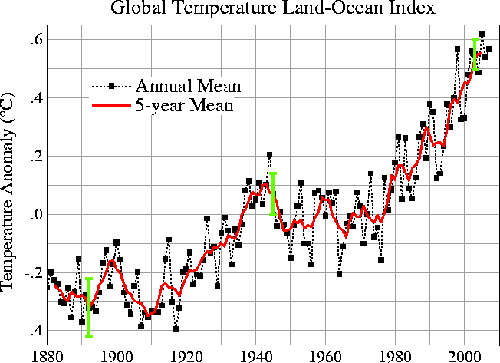(Part of the How to Talk to a Global Warming Skeptic guide)
Objection: There was global cooling in the ’40s, ’50s, and ’60s, even while human greenhouse-gas emissions were rising. Clearly, temperature is not being driven by CO2.
Answer: None of the advocates of the theory of anthropogenic global warming claim that CO2 is the only factor controlling temperature in the ocean-atmosphere climate system. It is a large and complex system, responsive on many different timescales, subject to numerous forcings. AGW only makes the claim that CO2 is the primary driver of the warming trend seen over the last 100 years. This rise has not been smooth and steady — nor would it be expected to be.

If you look at the temperature record for the 1990s, you’ll notice a sharp drop in ’92, ’93, and ’94. This is the effect of massive amounts of SO2 ejected into the stratosphere by Mount Pinatubo’s eruption. That doesn’t mean CO2 took a holiday and stopped influencing global temperatures; it only means that the CO2 forcing was temporarily overwhelmed by another, opposite forcing.
The situation is similar to the cooling seen in the ’40s and ’50s. During this period, the CO2 warming (a smaller forcing at the time) was temporarily overwhelmed by by other factors, perhaps foremost among them an increase in human particulates and aerosol pollution. Pollution regulations and improved technology saw a decrease in this latter kind of emissions over the ’60s and ’70s, and as the air cleared, the CO2 signal again emerged and took over. Below, courtesy of Global Warming Art, is an image of the current understanding of the factors and their influence for the climate of the past century.

As the graph shows, in addition to aerosol pollution (the sulphate line), volcanic influences were increasingly negative during the period of global cooling, and solar forcing slightly declined. All forcings taken together and run through the model are a very good match for the observations. (Please see the source page for details of what model and what study this image is derived from.)
Rather than confounding the climate consensus, mid-century cooling is actually a good test for the climate models, one they are passing quite convincingly.
Addendum: The opposing effect of cooling from airborne pollutants is often referred to as “Global Dimming“, and Real Climate has a couple of articles on it:
One emerging concern is that as the pollution causing this effect is gradually cleaned up, we may see even greater greenhouse gas warming.

